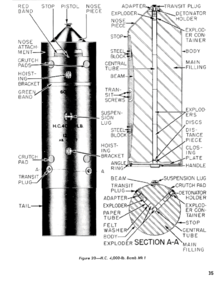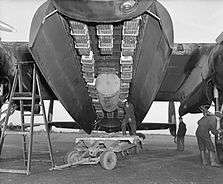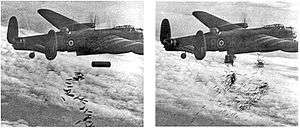Blockbuster bomb
A blockbuster bomb or cookie was any of several of the largest conventional bombs used in World War II by the Royal Air Force (RAF). The term blockbuster was originally a name coined by the press and referred to a bomb which had enough explosive power to destroy an entire street or large building through the effects of blast in conjunction with incendiary bombs.
Design

.jpg)
The bombs then called Blockbusters were the RAF's HC (High Capacity) bombs. These bombs had especially thin casings that allowed them to contain approximately three-quarters of their weight in explosive, with a 4,000-pound bomb containing over 3,000 pounds (1,400 kg) of Amatol. Most General-purpose bombs (termed Medium Capacity—or MC—by the RAF) contained 50% explosive by weight, the rest being made up of the fragmentation bomb casing. Blockbusters got larger as the war progressed, from the original 4,000 pounds (1,800 kg) version, up to 12,000 pounds (5,400 kg).
The Mark I 4000 lb bomb was a welded, cylindrical shell, made of 0.31-inch (7.9 mm) thick steel. The body of the bomb was 30 inches (76 cm) in diameter and 88 inches (2.2 m) long with a total overall length of 115 inches. The nose of the bomb was conical and a 27-inch (69 cm) long cylindrical tail was fitted (a lightweight, empty cylinder with a closed end). A T-section steel beam was welded to the inner surface of the bomb to strengthen it.[1] Subsequent Mark II and Mark III HC bombs differed in detail; the conical nose was replaced with a domed nose and the number of fuzes was increased from one to three, in order to guarantee detonation. The Mark IV bomb did not have the T-section beam. The Mark V and Mark VI bombs were versions manufactured in the United States.[2]
The larger 8,000 lb bomb was constructed from two 4,000 lb sections that fitted together with bolts, although these sections were of a larger 38 in (97 cm) diameter.[3] A 12,000 lb version was created by adding a third 4,000 lb section.[4][5]
The 4,000 lb high capacity design was little more than a cylinder full of explosives—it was unaerodynamic and did not have fins. The same weight American 4,000 lb (1.81 tonne) AN-M56 general purpose bomb was aerodynamically designed as its others were, with a sheet metal tailfin assembly and shaped nose and aft sections.[6] When fitted with a nose spoiler and a drum tail the British "blockbuster" bomb fell straight. These bombs were designed for their blast effect, to cause damage to buildings - specifically to blow roof tiles off, so that the smaller 4 lb (1.8 kg) incendiary bombs could reach the building interiors. These high capacity bombs were used only by the RAF, being too big to fit in the bomb bays of other aircraft.
In 1947 Alfred Cecil Brooks of Stourbridge was appointed a Member of the Order of the British Empire, for creating the Blockbuster, although his citation was worded "outstanding services to the King of a nature that cannot be revealed".[7] The local newspaper referred to him as "Blockbuster Brooks".
Operational use

The first type of aircraft to carry cookies operationally was the Wellington, but they later became part of the standard bomb load of the RAF's heavy night bombers, as well as that of the Mosquitoes of the Light Night Strike Force, whose aircraft would sometimes visit Berlin twice in one night carrying "cookies", flown by two different crews. The 8,000 lb (3,600 kg) and the 12,000 lb (5,400 kg) could only be carried by the Avro Lancaster, slightly modified with bulged bomb-bay doors.
First use of the 8,000 lb was by 15 Squadron Lancasters against Berlin on 2 December 1943. Bad weather and other factors meant their effectiveness was not noted.[8]
The 4,000 lb (1,800 kg) "cookie" was regarded as a particularly dangerous load to carry. Due to the airflow over the detonating pistols fitted in the nose, it would often explode even if dropped, i.e., jettisoned, in a supposedly "safe" unarmed state. Safety height above ground for dropping the 4,000 lb "cookie" was 6,000 ft; any lower and the dropping aircraft risked being damaged by the explosion's atmospheric shock wave:
We were flying at 6,000 feet which was the minimum height to drop the 4,000 pounder. We dropped it in the middle of town [Koblenz], which gave the aircraft a hell of a belt, lifted it up and blew an escape hatch from out of the top.[9]
Post-war unexploded ordnance

An unusual dry period led to low river levels in the Rhine in December 2011, exposing a 4,000 lb (1,800 kg) blockbuster in the riverbed near Koblenz. A radius of 2 km (1.25 miles) around the bomb site (containing about 45,000 people) was evacuated while the bomb was defused.[10] Another unexploded blockbuster was found in Dortmund in November 2013, requiring the evacuation of 20,000 people from the area.[11] A third was found and defused in Vicenza on 25 April 2014, requiring the evacuation of 30,000 within a radius of 2.5 km.[12]
Bombs
4000 lb HC bomb
![]() Media related to 4000 lb HC bomb at Wikimedia Commons
Media related to 4000 lb HC bomb at Wikimedia Commons
- Mark I: first production design
- Mark II: three nose pistols
- Mark III: no side pistol pockets
- Mark IV: no stiffening beam
- Mark V: U.S. production
- Mark VI: U.S. production
In 1943, 25,000 of these were used, this rose to 38,000 in 1944. In 1945 up to the end of the war a further 25,000 were used.
Other uses
Air mines

During The Blitz the Germans used naval mines dropped with parachutes as improvised blockbusters. Their fuze was triggered after the shock of landing, exploding after a 17-second delay; as the bomb was not in a crater, the force of the blast would disperse laterally, causing extensive damage.[13][14] The large raid on Coventry on 14 November/15 November 1940 included the use of 50 parachute naval mines, which caused extensive blast damage. The British called these devices air-mines,[15] a cognate for the German term Luftmine, their own name for these ordnance items. These types were used also during air raids on Malta, especially on its harbour areas.
In popular culture
- The slangy nature of the term "blockbuster" made it a frequent popular culture reference during World War II, for example the Bugs Bunny cartoon Falling Hare, which begins with a gremlin trying to detonate a blockbuster bomb with a mallet.
- The climax of the 1944 film The Canterville Ghost is a race to safely detonate a blockbuster bomb dropped in England.
- "Block Buster!" was a 1973 chart-topping song by British rock band Sweet, featuring the wailing sound of air raid sirens.
See also
- Pumpkin bomb, test Fat Man atom bomb casings filled with nearly six short tons of Composition B explosive
- MOAB
- BLU-82
- Firebombing
- Firestorm
References
- Citations
- ↑ Ordnance Pamphlet 1665 (1946) pp.36–37
- ↑ Ordnance Pamphlet 1665 (1946) pp.39
- ↑ Boyd, David. "8,000lb High Capacity Bomb". WWII Equipment.
- ↑ Boyd, David. "12,000lb High Capacity Bomb". WWII Equipment.
- ↑ Air Publication AP1661B Vol I
- ↑ Photo of standard American AN-M56 4,000 lb general purpose aerial bomb
- ↑ http://trove.nla.gov.au/newspaper/article/48780576. Missing or empty
|title=(help) - ↑ Maynard, John Bennett and the Pathfinders 1956 Arms and Armour Press. p148
- ↑ Jack Murray, pilot of "G for George", reporting on G for George's mission on 17th April 1943. Quoted in "G-for-George" by Michael Nelmes and Ian Jenkins. Banner Books, Maryborough QLD, 2002. ISBN 1-875593-21-7
- ↑ "Work to defuse WWII bomb in Rhine near Koblenz begins". BBC News. 4 December 2011. Retrieved 4 December 2011.
- ↑ Parry, Lizzie (3 November 2013). "Thousands of people evacuated from their homes in Germany after discovery of 4,000-pound World War Two bomb". Daily Mail. London.
- ↑ "Vicenza si prepara al Bomba Day. Evacuazione per 30 mila". OggiTreviso. Vicenza. 22 April 2014.
- ↑ The Luftwaffe over the Bristol area - Luftwaffe weapons
- ↑ Montague Trout comment in a Collaborative Article: The Blitz by Mark E
- ↑ Taylor, Fredrick; Dresden Tuesday 13 February 1945, Pub Bloomsbury (First Pub 2004, Paper Back 2005). ISBN 0-7475-7084-1. Page 120
- Bibliography
- "English Bombs of WWII". Canadian Aces. Constable.ca.
- British Explosive Ordanance (PDF) (Report). Ordnance Pamphlet. Department of the Navy, Ordnance Systems Command. 10 June 1946.
External links
| Wikimedia Commons has media related to 4000 lb HC bomb. |
- A 12,000lb HC blockbuster pictured in the factory minus-tail unit
- A 12,000lb HC blockbuster being dropped
- An 8,000lb HC blockbuster about to be loaded aboard a Lancaster
